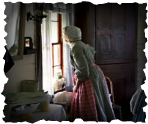|
Hello all, Rebecca Key here (Dawn Eggers). I had such a wonderful time this past weekend working and living as a rural woman of the 1860's. Occasionally I would find myself in a conversation with a spectator that would say, "I never see this impression, usually I see the lady all dressed up..." When I began reenacting living history my first inclination was to study all I could about the ladies of the 1860's; I was fascinated by the cage crinoline, the aniline dies, the water stained moire', the paisley shawls, and the modestly trimmed spoon bonnet. I fell in love with the ladies of the Sanitary Commission and the images of women knitting socks for the weary soldier miles away. I am still enamored with the fashions and how the cartridge pleated skirt lays just so upon the cage crinoline. As I continued to reenact event upon event I enjoyed seeing the many impressions portrayed and fashions worn, but rarely did I seem to see the rural woman in all her array. The woman that was at home on the farm working the land turning the soil for the winter wheat, hunting for wild game, running the homestead inside and out. At a National event, I would see occasional impressions of refugees poorly shod portraying the family ousted from their home by invading soldiers, but at home rarely did I see the woman with dirt under her nails wearing a wool apron stained with farm chores. About eight years ago, my mother and I worked intensely on our family genealogy. In our unraveling of the past, we found many of our ancestors were just that...the woman working the farm while the men were gone fighting for both the Confederacy as well as the Federal troops. It was shortly after that I decided to hang up the cage crinoline and bring my ancestors to life. I have never been so enamored with history as I am now! Suddenly a whole new world opened up to me. Now at an event you will see me toting my faggot (or stick bundle) tied on my back with my pipe in my mouth, or skinning a squirrel for the pot. Interesting enough, there are many Godey and Peterson publications and thousands of CDV's of the woman of 1860 dressed in her best, but to find a rural everyday woman in a photo or diary entry is very difficult. For example we all can find multiple sources for a woman's corset of 1860, but what about a foundational garment for the farm wife who is in need of freedom of movement for milking the cows, or blackening the stove? The rural woman may not have been as advanced in fashion as those in the city; it is my guess she wore a work stay not unlike what her mother wore before her...practical yet supportive for the hard life of the farm. According to The Expansion of Everyday Life by Daniel E. Sutherland, "Yet truth be told, the majority of farmers in the Civil War era did not have to worry about mechanical reapers. They still turned the soil with a plow and seeded it by hand..." So many accounts tell of how long it took the rural areas to assume the modern technology and styles of the city. So here's to the everyday woman who was probably the majority of our ancestors in 1860...the cage crinoline of the city, the wealthy to the upper middle class has its place, but the rural woman was the one that toiled to make the cloth, food, and struggled to survive. I for one am thankful for my rural grandmothers!
1 Comment
|
Dawn Marie also known as Rebecca
|


 RSS Feed
RSS Feed


